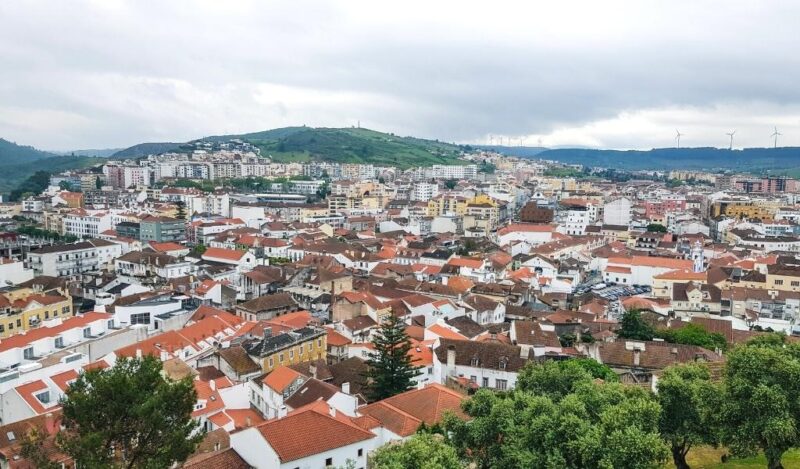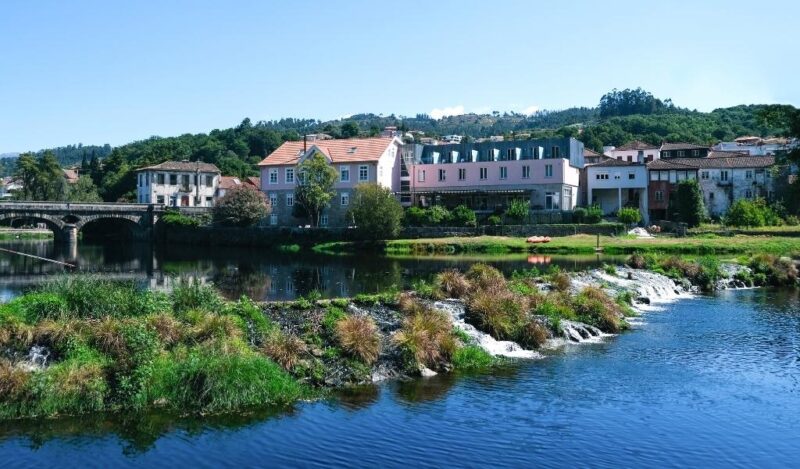Penafiel is a city and municipality in the Porto district, located 40 km from the northern capital. This means that this Penafiel itinerary is ideal for a day trip from Porto or even the perfect stop on a road trip through the Tâmega e Sousa sub-region (in the North Region)!
Penafiel has a historical and cultural heritage of incalculable value, both in its historic center and the city’s surroundings. In addition, it’s a place of stunning natural beauty, thanks to its green hills and valleys, and its paradisiacal river beaches on the Tâmega River!
So, do you want to know more about the 1 Day In Penafiel: The Perfect Penafiel Itinerary? Keep reading!
This post may contain affiliate links, meaning I earn a small commission if you make a purchase, at no additional cost to you. Please read my disclosure & privacy policy for more information.
No time to read now? Pin it for later!


Brief History of Penafiel
The region where Penafiel is located today has always been a crossing point for important land and river communication routes, and for this reason, has been populated since prehistoric times. And proof of this is archaeological sites such as the Castro of Monte Mozinho.


In the Middle Ages, this entire geographical area that connects the coast to the mountains subsisted on farming, livestock, and fishing activities. At the same time, land belonging to the Church began to proliferate, many of them associated with Benedictine monasteries that still exist today.
Originally called Arrifana de Sousa, the city and municipality of Penafiel received its current name on March 3rd, 1770, by royal charter from King José I!
Visiting Penafiel
In my opinion, the best way to visit the city of Penafiel is on a day trip from Porto. And to get there from the capital of Northern Portugal, you have two options: travel by car (around 40 km) or by public transportation (30-45 minutes by bus).
However, Penafiel is also an excellent stop on a road trip through the Tâmega and Sousa sub-region or the Porto district! In that case, I suggest you explore other destinations in the vicinity: Paredes (4 km), Lousada (10 km), Paços de Ferreira (15 km), Marco de Canaveses (19 km), Castelo de Paiva (21 km), Amarante (26 km) or Valongo (26 km).
Penafiel Itinerary
Castro of Monte Mozinho
This Penafiel itinerary starts at the Castro of Monte Mozinho (in Portuguese, Castro de Monte Mozinho), the most important archaeological site in the city. Also nicknamed the “Dead City of Penafiel”, this set of ruins covers around 20 hectares – making it the largest Roman castro in the Iberian Peninsula!

The Castro of Monte Mozinho was founded between the end of the 1st century BC and the beginning of the 1st century AD, having been occupied until the 5th century. At an altitude of over 400 meters, it was made up of family houses and daily life support structures, such as stone ovens and animal shelters!
Read my complete guide to the Castro of Monte Mozinho, a must-see tourist attraction on any Penafiel itinerary!
“Serpe”
The next stop on this Penafiel itinerary is the “Serpe”, a steel sculpture designed by the plastic artist José de Guimarães. Inaugurated on June 21st, 2014, the work can be found in the Calvary Garden (in Portuguese, Jardim do Calvário), a few meters from the Calvary Church (in Portuguese, Igreja do Calvário).

Sometimes called the Bicha-Serpe, the Serpe is a winged reptile similar to a dragon, which is part of the profane procession of the Corpus Christi procession. Traditionally, this figure represents evil and sin, which Jesus Christ managed to overcome.
Misericórdia Church
This Penafiel itinerary continues at the Misericórdia Church (in Portuguese, Igreja da Misericórdia), an imposing monument that is surrounded by other points of interest, such as the Penafiel Pillory, the Penafiel City Hall, or the Monument to the Dead of the Great War.

Dating back to the 17th century, the Misericórdia Church of Penafiel underwent several alterations throughout that same century and the next. And, inside, it’s possible to distinguish Baroque and Neoclassical elements – such as the stalls and the altars, respectively.
Municipal Museum of Penafiel
The next stop on this Penafiel itinerary is the Municipal Museum of Penafiel (in Portuguese, Museu Municipal de Penafiel), which opened in March 2009 in the renovated Pereira do Lago Palace. And the following year, it was distinguished with the “Best Portuguese Museum Award” and nominated for the “European Museum of the Year Award (EMYA)”!


The collection of the Municipal Museum of Penafiel is divided into five permanent exhibition rooms, dedicated to the history and culture of the municipality – Identity Room, Territory Room, Archaeology Room, Crafts Room, and Earth and Water Room – with an extra room for temporary exhibitions!
Read my complete guide to the Municipal Museum of Penafiel, a must-see tourist attraction on any Penafiel itinerary!
Church of Our Lady of Help
This Penafiel itinerary continues at the Church of Our Lady of Help (in Portuguese, Igreja de Nossa Senhora da Ajuda), a small Catholic temple installed in the historic center of the city. If it weren’t for its façade of blue and white tiles, I confess that I wouldn’t even see this magnificent architectural work, as it’s so well camouflaged among the other buildings!


The Church of Our Lady of Help was erected between the 18th and 19th centuries, and its style is mostly late Baroque. Managed by the Sisterhood of Our Lady of Help, its patron saint is Our Lady of Help – which can be seen on the main façade.
Chapel of Saint Bartholomew
The next stop on this Penafiel itinerary is the Chapel of Saint Bartholomew (in Portuguese, Capela de São Bartolomeu), a religious monument that was demolished in 1895. Its name is a reference to Saint Bartholomew’s Hill (in Portuguese, Monte de São Bartolomeu), which begins precisely at the location of these ruins.

The Chapel of Saint Bartholomew dates from the mid-18th century, as it’s known that its patron saint was transferred here around 1758. However, the Catholic temple was deactivated a few decades later and the image of Saint Bartholomew ended up being accommodated at the Sanctuary of Our Lady of Mercy and Holy Steps.
Sanctuary of Our Lady of Mercy and Holy Steps
This Penafiel itinerary continues at the Sanctuary of Our Lady of Mercy and Holy Steps (in Portuguese, Santuário de Nossa Senhora da Piedade e dos Santos Passos), better known as Sameiro Church (in Portuguese, Igreja do Sameiro). Built at the end of the 19th century in a romantic style, this Catholic temple is located on Saint Bartholomew’s Hill, the highest point in the city!


The Sanctuary of Our Lady of Mercy and Holy Steps (or Sameiro Church) is open every day, from 9:30 am to 12 pm and from 2:30 pm to 6 pm (in summer time); or from 9:30 am to 12 pm and from 2:30 pm to 5 pm (in winter time). And although the entrance is free, it’s not allowed to photograph or film its interior.
Sameiro Garden
The last stop on this Penafiel itinerary is the Sameiro Garden (in Portuguese, Jardim do Sameiro), whose official name is Zeferino de Oliveira Park (in Portuguese, Parque Zeferino de Oliveira). Considered the main green park in Penafiel, the Sameiro Garden has wonderful views over the historic part of the city and the Sousa River Valley.


The Sameiro Garden (or Zeferino de Oliveira Park) was designed between the end of the 19th century and the beginning of the 20th century, at the same time as the Sanctuary of Our Lady of Mercy and Holy Steps. And nowadays, it’s the favorite viewpoint for locals and tourists who visit Penafiel!
Map of the Penafiel Itinerary
Share this blog post on your social media!
More Posts about Portugal
4 Best Monasteries In Portugal (That You Should Visit This Year)
5 Best Palaces In Sintra (That You Should Visit This Year)
Biscainhos Museum: Best Tips For Visiting In 2024
More Posts about Travel Itineraries
1 Day In Torres Vedras: The Perfect Torres Vedras Itinerary
2 Days In Arcos De Valdevez: The Perfect Arcos De Valdevez Itinerary
1 Day In Alcobaça: The Perfect Alcobaça Itinerary
What Photography Gear Do I Use?
- Camera Body: Fujifilm X-T4 Mirrorless
- Camera Lens: Fujinon XF 18-55 mm F2.8-4 R LM OIS
- Tripod: Manfrotto Compact Action
- Small Tripod: Manfrotto PIXI Mini
- Smartphone Adaptor: Manfrotto PIXI Clamp
- Memory Card: SanDisk 128GB Extreme PRO SDXC






